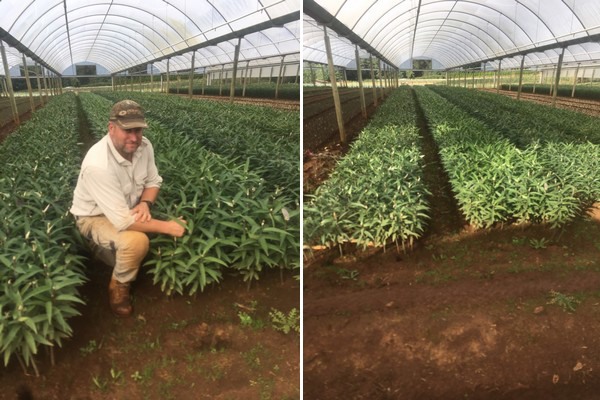"This topping process has not been used in the Monbulk region for over 20 years", says Australian flower grower Bernie Badgery of Robin Rise Flowers. On 3ha in the Dandenongs region, 50 km from Melbourne CBD, he mainly grows summer/autumn Liliums (LA and OT), Kale, Snapdragons, Primula and Iris. When sales came to a halt after the government tightened the coronavirus measures this flower grower decided to "top" a part of his lilium production. This process ensures that a Lily crop can be harvested next season without having the expense of buying new bulbs.
 Bill Badgery.
Bill Badgery.
Region - Ideal conditions for bulb crops
Robin Rise Flowers was established in 2003 and owned and operated by the brothers Bill and Bernie Badgery. They are located close to many other flower growers and this region accounts for over 40% of flowers grown in Australia. "The rich red alluvial soils and cool higher altitude region (265m) make it ideal for a range of bulb crops including Liliums, Tulips, Iris, Narcissus. Additional crops grown in this area including Paeony, Zantedeschia plus foliage lines Magnolia, Camelia and Viburnum."
Impact COVID-19
Like other areas around the world, the Australian government enforced shut down of many sectors of the country's economy. Fortunately, the actions are proving effective - with 7,000 infected cases and 70 deaths in Australia caused by the coronavirus - but are affecting, like in many other countries, the flower growers. “Our flower sales came to a halt when the government introduced stage 3 restrictions and this slow down lasted for around 2 weeks,” said Bill Badgery.
Lift in sales
“The last 2 weeks has seen a much improved lift in sales in Adelaide, Sydney and Melbourne. Prices remain on the low side but we are pleased to see product moving on a consistent basis.”
Topping the crop
In the midst of the sales slowdown, Robinrise Flowers decided to “top” 3 poly houses of OT Lilies. This process involves cutting the immature flower stem approximately 60cm from the ground. The planned flower crop is then sacrificed and the bulb is left in the ground for 12 months.
The process of “topping” is an inexact science but it will ensure a lily crop is harvested next season without having the expense of buying new bulbs.
Bernie Badgery said this topping process has not been used in the Monbulk region for over 20 years. "Before the supply of southern hemisphere bulbs from Chile and New Zealand were made available, topping was used to help produce a summer lily crop.”said Bernie. He continues, "The topping process was quite commonly used with Lilium longiflorum which are referred to as Christmas lilies in Australia"
Mother's Day
Australian flower growers are now approaching Mother’s Day which is celebrated in Australia on the second Sunday of May (May 10 this year). "Mother’s Day is by far the business flower trading period in Australia with many crops that were planned and planted well before the coronavirus decimated our economy and flower consumption. Hopefully, by that time, flower sales will pick up a bit.
Story provided by Adrian Parsons, Helix Australia
For more information
Helix Australia
Adrian Parsons, Managing Director
E-mail: adrian@helixaustralia.com.au
www.helixaustralia.com.au
